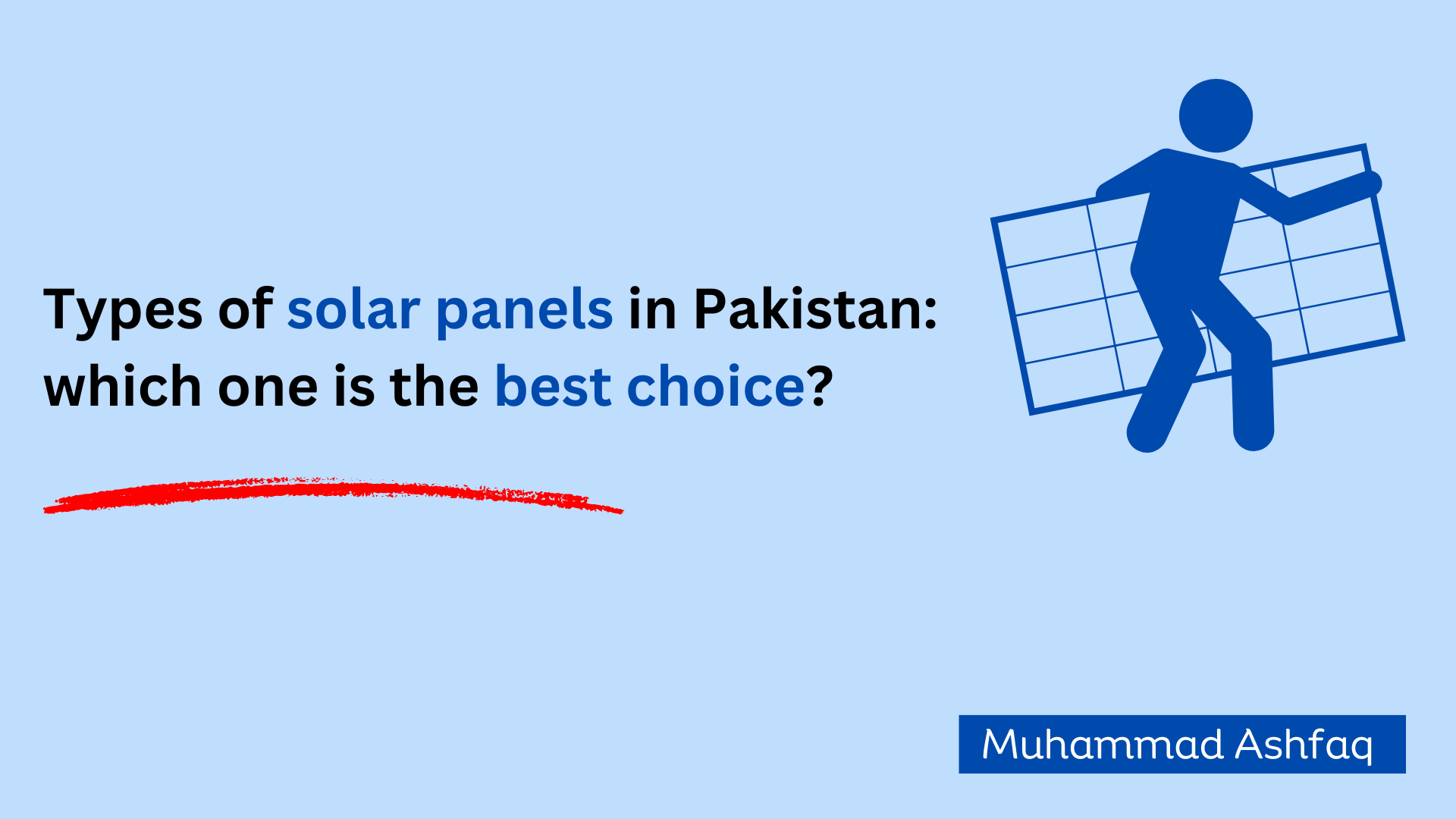Monocrystalline vs Polycrystalline Solar Panels
Choosing the right solar panels can feel overwhelming, but understanding the basics makes the decision easier.
There are three main types of solar panels available: monocrystalline, polycrystalline, and thin-film. Each type has unique advantages in terms of efficiency, cost, and performance.
Monocrystalline panels are ideal for colder areas due to their high efficiency, while polycrystalline panels are more cost-effective and perform well in hotter regions.
I’m here to help you pick the perfect solar panel for your home (no more guesswork).
Monocrystalline Solar Panels: The High-Efficiency Choice
When it comes to solar energy, monocrystalline solar panels stand out as a high-efficiency option. These panels are made from a single, continuous crystal of silicon, which allows them to convert sunlight into electricity with an efficiency ranging from 17% to 22%.
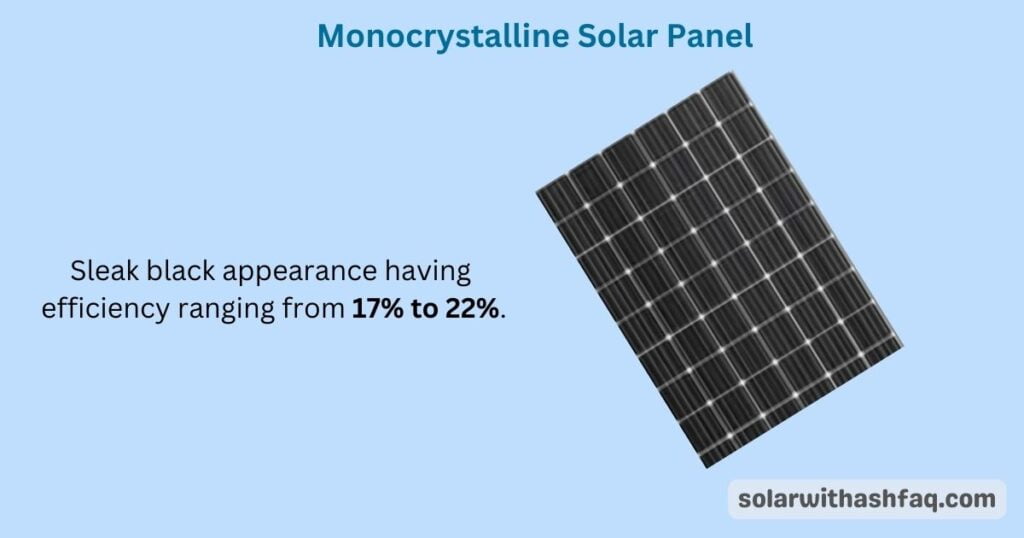
One key advantage of monocrystalline solar panels is their performance in colder environments, making them ideal for northern areas of Pakistan (including Islamabad and Rawalpindi).
The single-crystal silicon used in their construction is highly light-sensitive, making these panels generate more power even in cooler temperatures.
Compared to other solar panel technologies, monocrystalline panels have a sleek, uniform appearance with a black look.
Generally, they are more space-efficient and produce more power per square foot.
Polycrystalline Solar Panels: A Balance of Cost and Performance
If you’re looking for a balance of cost and performance, polycrystalline solar panels are the way to go.
These panels are made up of multiple silicon crystals fused together, giving them a distinctive blue look.
While they are not as efficient as their monocrystalline counterparts, polycrystalline panels tend to be more affordable.
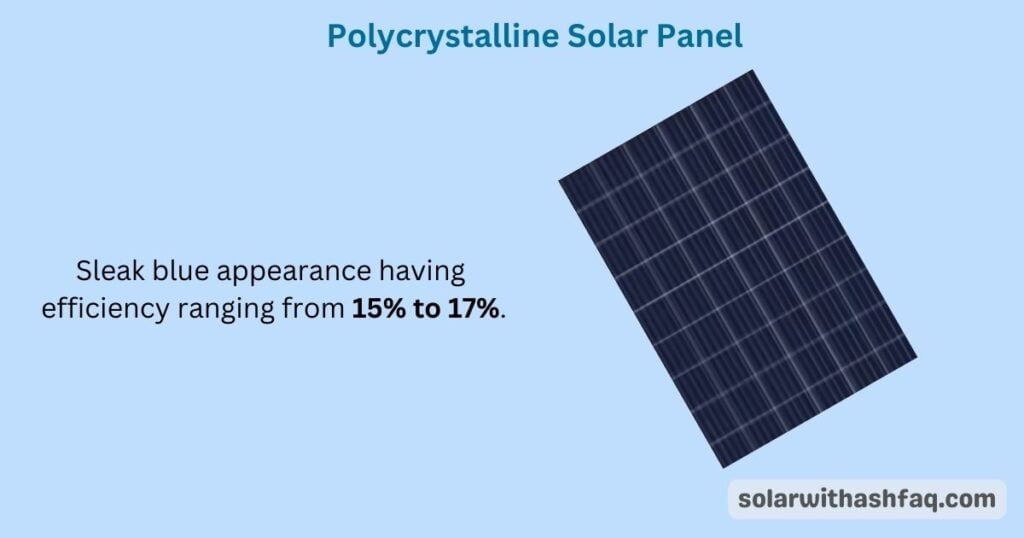
Polycrystalline panels’ efficiency ranges from 15% to 17%, making them a great choice for homeowners in warm climates.
The silicon crystals in these panels are less sensitive to heat than the single-crystal structure of monocrystalline panels.
That means they can maintain their efficiency even in the scorching heat.
Thin-Film Solar Panels: Lightweight and Flexible Option
There’s a lot to know about thin-film solar panels, as they are the least discussed. Are these lightweight, flexible panels the right choice for your home?
Let me break down the key benefits and considerations.
Thin-film solar panels comprise one or more thin layers of photovoltaic materials, which means they can be over 300 times thinner than traditional silicon panels.
This makes them incredibly lightweight and easy to install, even on rooftops that can’t support the weight of bulky panels.
Their efficiency is typically in the 10-13% range, lower than silicon.
You might be wondering, if they’re less efficient, why would I choose thin film?
Well, the lower cost per watt can make them an attractive option. And their lightweight, flexible design means they can be installed in more places than bulky silicon panels.
The only downside is that thin-film solar is less widely used, so there may be fewer options and installers familiar with the technology in Pakistan.
However, as technology continues improving, thin-film solar panels will become a more popular choice for homeowners and commercial rooftops.
Also Explore: Top Rated Solar Panels Price & Reviews [2024]
Which Solar Panel is the Right Choice for Your Home
Choose Monocrystalline Solar Panels if:
- You want the most efficient solar panels on the market
- You have limited roof space and need to maximize energy production
- You live in cold climates like Azad Kashmir, KPK, and Islamabad
Choose Polycrystalline Solar Panels if:
- You have ample roof space and don’t need the highest efficiency
- You’re looking for a good balance of cost and performance
- You live in warm climates like Lahore, South Punjab, and Sindh
Choose Thin-Film Solar Panels if:
- You need a lightweight, flexible solar panel option
- Your roof has a lot of shade or irregular angles
- You’re on a tight budget and want the most cost-effective solution
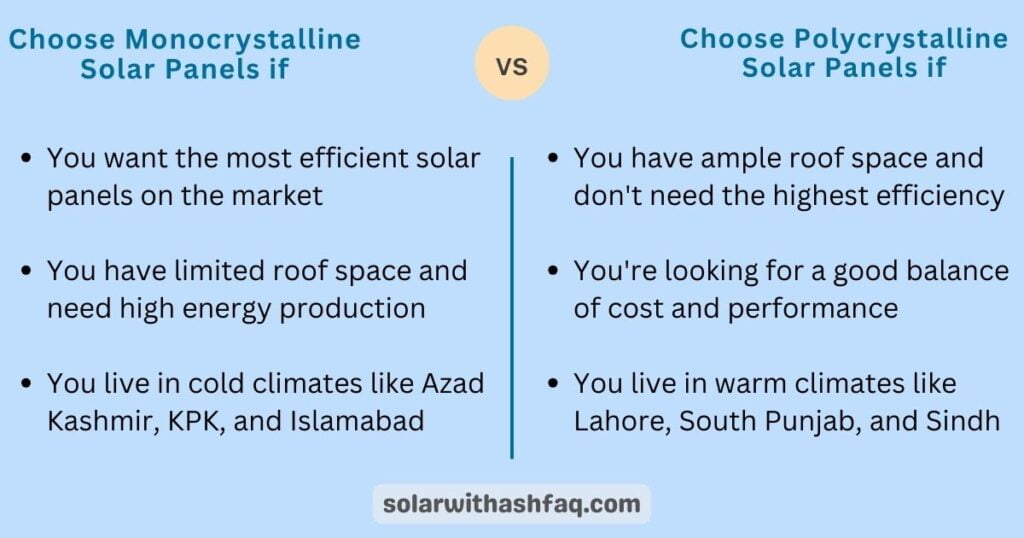
Other Types of Solar Panels Based on Different Techniques
The most common types of solar panels are discussed above. They are categorized based on the manufacturing process.
But when you go to the market, things get confusing when you see solar panels labeled with terms like “half-cut,” “bifacial,” “PERC,” etc.
These aren’t entirely new types but rather techniques used to improve efficiency and performance.
I’m here to explain it to you so that you can go to the market with confidence (and make things tough for the vendor).
Bifacial Solar Panels
Bifacial solar panels are a bit different from traditional solar panels. They are designed to absorb sunlight from both the front and the back of the panel and generate more electricity than traditional monofacial panels.
Top panel manufacturers like Longi Solar and Canadian Solar provide a wide range of panels with different wattages in Pakistan.
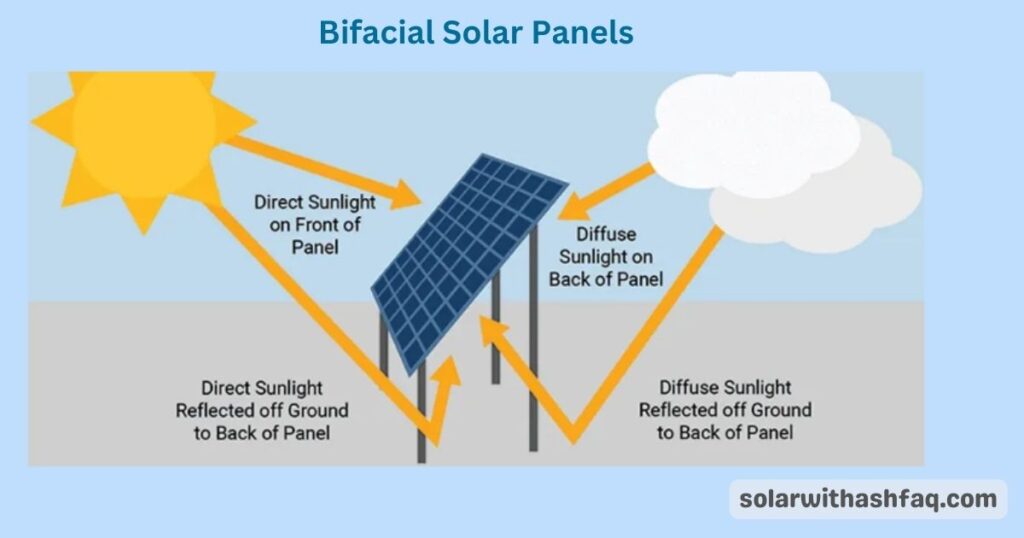
In fact, a study by solar panel manufacturer LONGi Solar found that bifacial panels can increase energy efficiency by up to 11% compared to a conventional solar system.
This is particularly beneficial due to:
- Increased energy output
- Better performance in areas with high levels of diffuse light
Investing in bifacial solar panels could be a wise choice if you live in an area of Pakistan that experiences a lot of diffuse light, such as near the coast or in mountainous regions.
PERC Solar Panels
First, let’s address a common issue with traditional solar panels—electron recombination.
When sunlight hits a solar panel, some of the light passes through the cell without exciting the electrons. This unused light then hits the aluminum surface (at the bottom) and heats the metal contacts, which can hinder the flow of electrons.
PERC (Passivated Emitter and Rear Cell) solar panels solve this problem by adding a special passivated layer to the back of the module. This layer reflects the unused light back into the cell, excitng more electrons and generating more electricity.
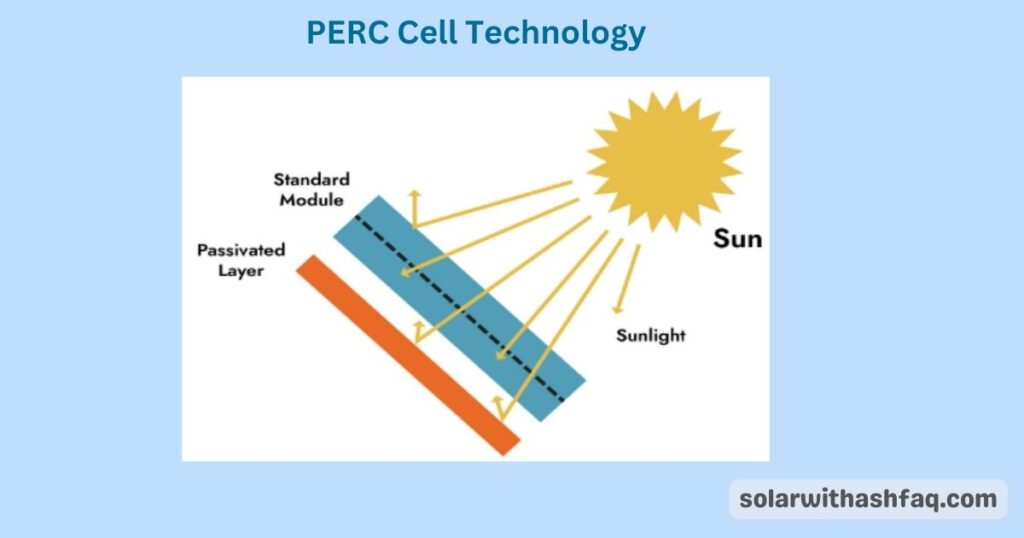
By reducing electron recombination, PERC panels can achieve higher efficiency by up to 23%.
The best part? PERC solar cells are relatively easy for manufacturers to produce, using much of the same equipment and materials as traditional solar cells.
These panels are best suited due to:
- Increased energy production
- Better performance in low-light conditions
- High efficiency levels even in hot climates
Topcon Solar Panels
Introduced by the renowned Fraunhofer Institute for Solar Energy Systems in 2013, Topcon technology is a game-changer.
It pairs a tunneling oxide layer with a PERC (Passivated Emitter and Rear Contact) solar cell to further reduce recombination losses and increase cell efficiency.
The working principle behind TOPCon cells is selective charge carrier transport and advanced passivation techniques. These techniques allow them to convert sunlight into electricity with remarkable efficiency, often exceeding 25%.
In simpler terms, Topcon panels are designed to convert more of the sun’s energy into usable electricity for your home.
They are well suited due to:
- Highest efficiency so far
- Enhanced bi-faciality
- Lower degradation over time
Wrapping Up
In conclusion, when choosing the best solar panels for your home, you must consider your specific needs and priorities.
Monocrystalline panels offer the highest efficiency, making them ideal for limited roof space, while polycrystalline panels balance cost and performance.
Thin-film solar is a lightweight, flexible option for those on a tighter budget.
Top brands like Longi, Jinko, and Canadian Solar offer high-quality panels of all the above types to meet the diverse needs of Pakistani homeowners.
Frequently Asked Questions
Both LONGi and Jinko are reputable solar panel manufacturers. The choice between them depends on your needs, budget, and preferences.
Monocrystalline solar panels, made from single-crystal silicon, are the highest-efficiency option. Polycrystalline panels are slightly less expensive but slightly lower-efficient. Thin-film solar panels are the most cost-effective but also have lower efficiency rates. Bifacial solar panels, a newer technology, can capture sunlight from both sides, boosting overall energy production.
The maximum wattage of solar panels in Pakistan can vary, with some panels reaching up to 585 watts. It’s essential to check with local suppliers for the latest high-wattage options.
Both LONGi and Jinko solar panels are known for their durability and resilience. They are designed to withstand extreme weather conditions, making them solid choices for homeowners.
The big advancements in 2024 are PERC and Topcon solar panels. PERC stands for Passivated Emitter and Rear Cell, a new cell structure that improves efficiency. Topcon is a novel cell design that also boosts efficiency compared to standard panels. Both of these technologies are expected to become more mainstream in the next couple of years.

Content Writer | Assistant Manager (Electrical) at IESCO
As a passionate content writer, I’m on a mission to make solar hassle-free for you through my expert guides and easy-to-digest content.

